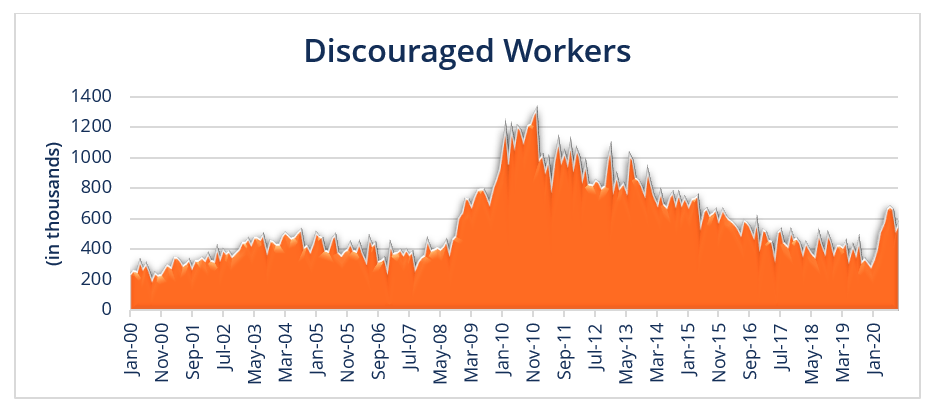Discouraged Workers
Workers who have been actively looking for work but have given up due to feeling discouraged from consistent unemployment
Who are Discouraged Workers?
Discouraged workers are a group of individuals in an economy who have been actively looking for work but have given up due to feeling discouraged from consistent unemployment and failed efforts of looking for work opportunities. Also referred to as marginally attached to the labor force, discouraged workers are excluded when calculating the unemployment rate.

Criteria for Classification
The U.S. Bureau of Labor Statistics (BLS) recommends the following criteria necessary to deem someone as a discouraged worker. The individual must:
- Be actively looking for work
- Want work
- Is available to work
- Has not looked for work in the last four weeks
- Has looked for work in the past 12 months
- Feels “discouraged” from looking for work due to the lack of suitable job opportunities or low confidence in their qualifications
Reasons Why People Stop Looking for Employment
Below are some instances when an individual may lose motivation to look for employment opportunities:
- Oftentimes, discouraged workers haven’t looked for work in a long time and have lost all hope of returning to the labor force altogether.
- They may not have faith in their skills/training, and hence, do not feel equipped to be confident in today’s competitive working population.
- In today’s technologically advanced times, employers prefer young workers – compared to those who are older – due to obsolete skills and/or their inability to grasp new skills quickly. According to a BLS survey, they found that 27% of discouraged workers were 55 years or older.
- Illness/disability and personal reasons such as returning to school are major drivers that also raise the number of discouraged workers.
- Some people also hope to return to their most recent job and wait instead of looking for other opportunities.
There is an intricate relationship between the unemployment rate and discouraged workers. The unemployment rate is calculated through six different approaches in the U.S. categorized as U1, U2, U3, U4, U5, and U6. There is a fundamental difference caused by discouraged workers in the unemployment rates.
U6 differs from U3 in the sense that it accounts for discouraged workers in the U.S. Even though U3 is the main rate used to depict unemployment in the country, U6 is used to represent a holistic picture of those who are unemployed, marginally attached to the labor force, and those who are employed part-time – providing a true representation of unemployment within the country.
Global Discrepancy Around “Discouraged Workers”
Although discouraged workers are a globalized category of unemployed individuals, the definition and criteria that classify them as such differ across countries. Canada, the north-side neighbor of the United States, distinguishes discouraged workers as those who are hidden unemployed due to their behavior patterns that lead people to give up on looking for jobs.
As opposed to the U.S.’ condition of one looking for work in the past year, Canada classifies a discouraged worker as someone who must’ve looked for jobs in the last six months. Methods and questions asked that determine the status of discouraged workers differ from country to country, and therefore, there are caveats in generalizing the understanding of discouraged workers for who they are and comprise of.
Discouraged Workers and Their Effect on the Economy

The Labor Force Participation Rate is calculated by dividing the labor force by the working population. When a recession hits, the number of discouraged workers increases as the labor force decreases since they drop out due to unsuccessful attempts at looking for jobs in the middle of an economic slump.
In current times, adverse events such as the COVID-19 pandemic affect discouraged workers and the global economy in a similar way. The Federal Reserve expects the U.S. unemployment rate to reach up to 32% in the second quarter, which is a drastic increase from 3.6% in 2019.
Additional Resources
CFI is the official provider of the global Capital Markets & Securities Analyst (CMSA)® certification program, designed to help anyone become a world-class financial analyst. To keep advancing your career, the additional CFI resources below will be useful: